Health and wellbeing Introduction Falls among the elderly
VerifiedAdded on 2023/04/24
|13
|3511
|467
AI Summary
Contribute Materials
Your contribution can guide someone’s learning journey. Share your
documents today.
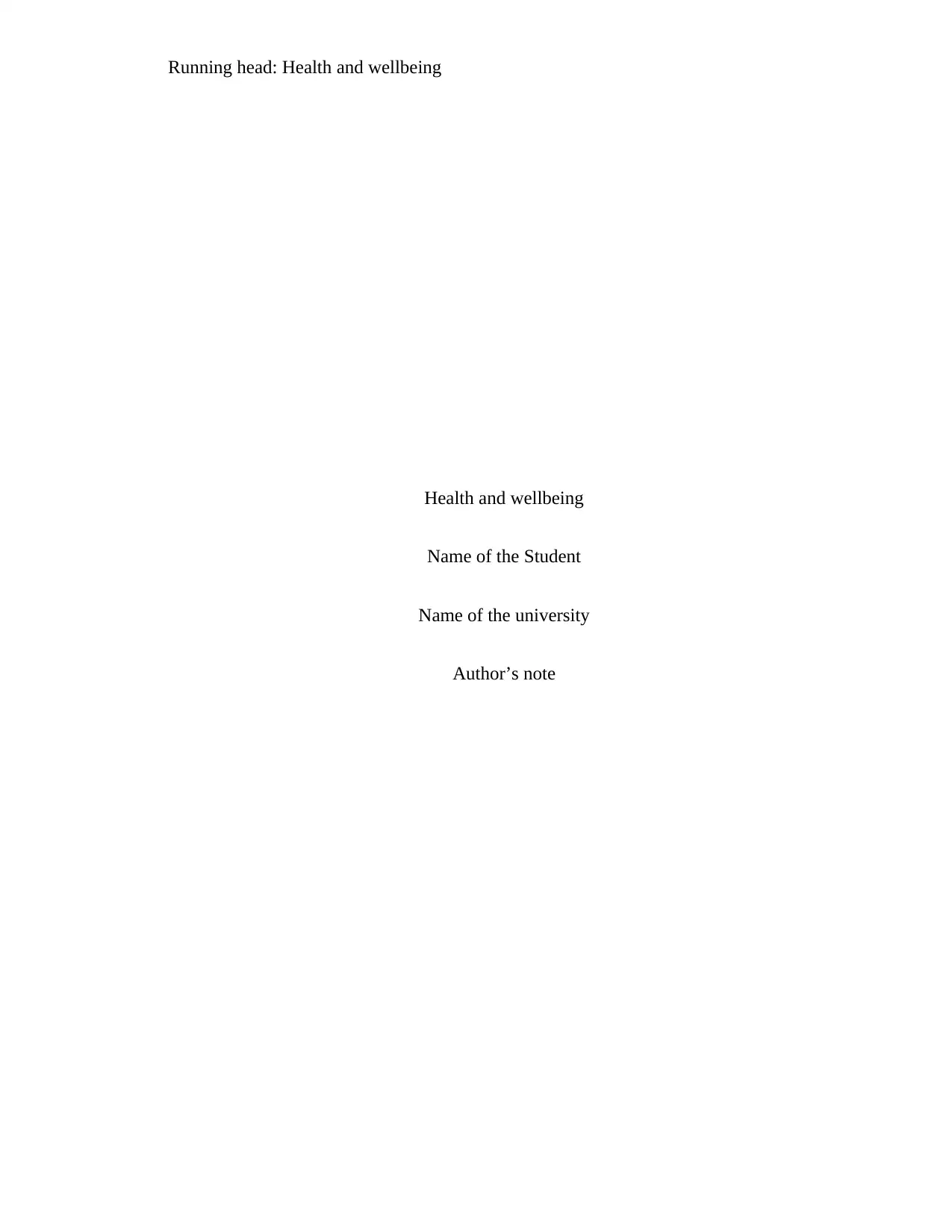
Running head: Health and wellbeing
Health and wellbeing
Name of the Student
Name of the university
Author’s note
Health and wellbeing
Name of the Student
Name of the university
Author’s note
Secure Best Marks with AI Grader
Need help grading? Try our AI Grader for instant feedback on your assignments.
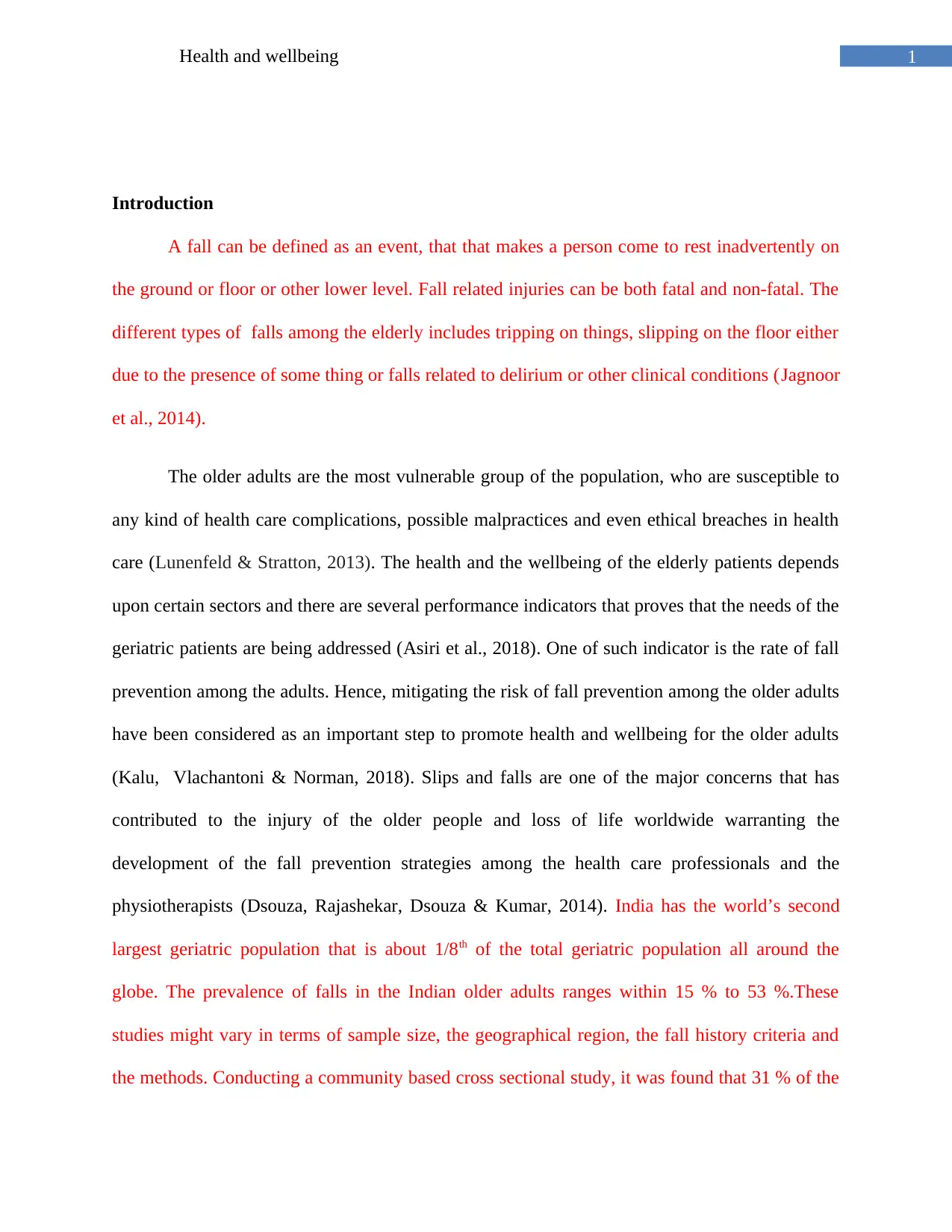
1Health and wellbeing
Introduction
A fall can be defined as an event, that that makes a person come to rest inadvertently on
the ground or floor or other lower level. Fall related injuries can be both fatal and non-fatal. The
different types of falls among the elderly includes tripping on things, slipping on the floor either
due to the presence of some thing or falls related to delirium or other clinical conditions (Jagnoor
et al., 2014).
The older adults are the most vulnerable group of the population, who are susceptible to
any kind of health care complications, possible malpractices and even ethical breaches in health
care (Lunenfeld & Stratton, 2013). The health and the wellbeing of the elderly patients depends
upon certain sectors and there are several performance indicators that proves that the needs of the
geriatric patients are being addressed (Asiri et al., 2018). One of such indicator is the rate of fall
prevention among the adults. Hence, mitigating the risk of fall prevention among the older adults
have been considered as an important step to promote health and wellbeing for the older adults
(Kalu, Vlachantoni & Norman, 2018). Slips and falls are one of the major concerns that has
contributed to the injury of the older people and loss of life worldwide warranting the
development of the fall prevention strategies among the health care professionals and the
physiotherapists (Dsouza, Rajashekar, Dsouza & Kumar, 2014). India has the world’s second
largest geriatric population that is about 1/8th of the total geriatric population all around the
globe. The prevalence of falls in the Indian older adults ranges within 15 % to 53 %.These
studies might vary in terms of sample size, the geographical region, the fall history criteria and
the methods. Conducting a community based cross sectional study, it was found that 31 % of the
Introduction
A fall can be defined as an event, that that makes a person come to rest inadvertently on
the ground or floor or other lower level. Fall related injuries can be both fatal and non-fatal. The
different types of falls among the elderly includes tripping on things, slipping on the floor either
due to the presence of some thing or falls related to delirium or other clinical conditions (Jagnoor
et al., 2014).
The older adults are the most vulnerable group of the population, who are susceptible to
any kind of health care complications, possible malpractices and even ethical breaches in health
care (Lunenfeld & Stratton, 2013). The health and the wellbeing of the elderly patients depends
upon certain sectors and there are several performance indicators that proves that the needs of the
geriatric patients are being addressed (Asiri et al., 2018). One of such indicator is the rate of fall
prevention among the adults. Hence, mitigating the risk of fall prevention among the older adults
have been considered as an important step to promote health and wellbeing for the older adults
(Kalu, Vlachantoni & Norman, 2018). Slips and falls are one of the major concerns that has
contributed to the injury of the older people and loss of life worldwide warranting the
development of the fall prevention strategies among the health care professionals and the
physiotherapists (Dsouza, Rajashekar, Dsouza & Kumar, 2014). India has the world’s second
largest geriatric population that is about 1/8th of the total geriatric population all around the
globe. The prevalence of falls in the Indian older adults ranges within 15 % to 53 %.These
studies might vary in terms of sample size, the geographical region, the fall history criteria and
the methods. Conducting a community based cross sectional study, it was found that 31 % of the
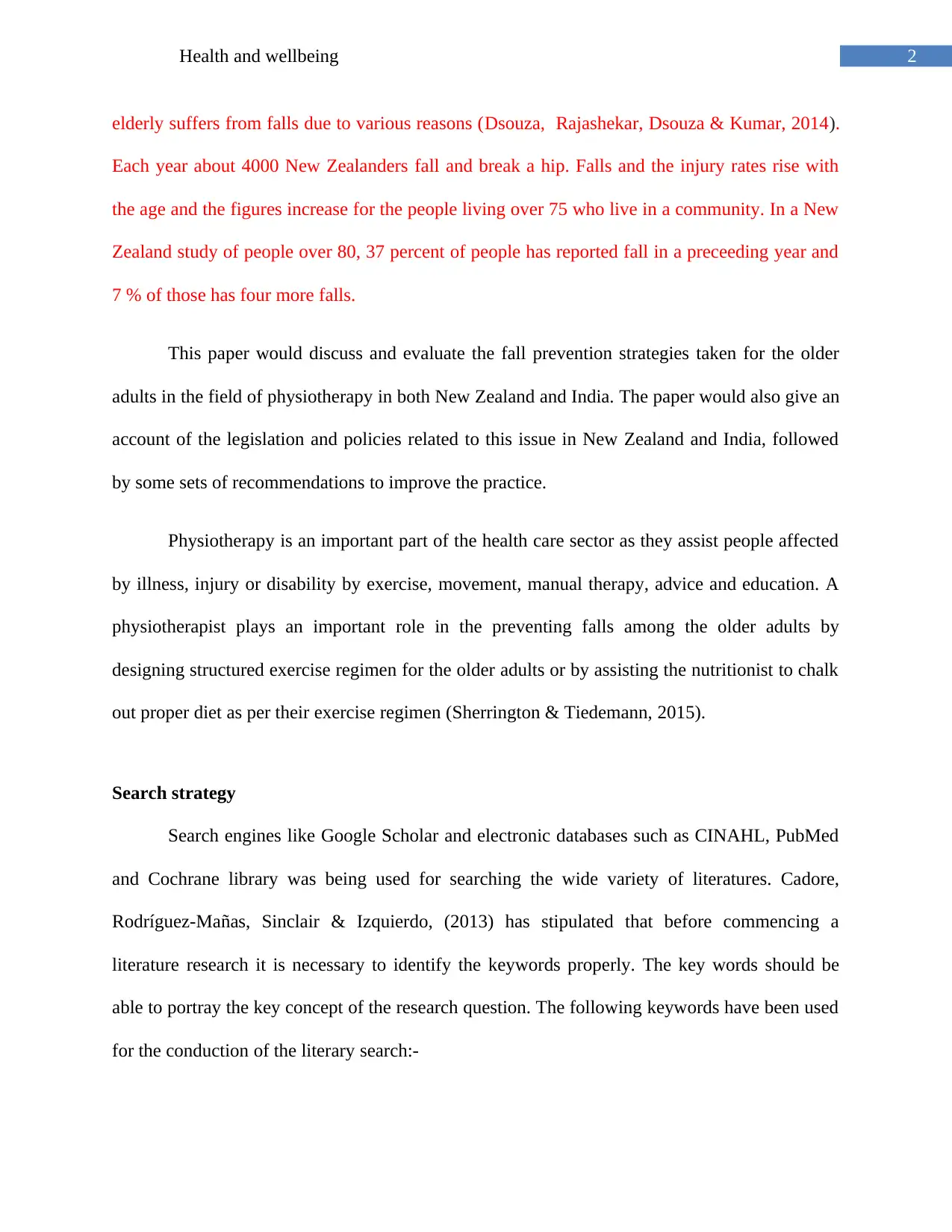
2Health and wellbeing
elderly suffers from falls due to various reasons (Dsouza, Rajashekar, Dsouza & Kumar, 2014).
Each year about 4000 New Zealanders fall and break a hip. Falls and the injury rates rise with
the age and the figures increase for the people living over 75 who live in a community. In a New
Zealand study of people over 80, 37 percent of people has reported fall in a preceeding year and
7 % of those has four more falls.
This paper would discuss and evaluate the fall prevention strategies taken for the older
adults in the field of physiotherapy in both New Zealand and India. The paper would also give an
account of the legislation and policies related to this issue in New Zealand and India, followed
by some sets of recommendations to improve the practice.
Physiotherapy is an important part of the health care sector as they assist people affected
by illness, injury or disability by exercise, movement, manual therapy, advice and education. A
physiotherapist plays an important role in the preventing falls among the older adults by
designing structured exercise regimen for the older adults or by assisting the nutritionist to chalk
out proper diet as per their exercise regimen (Sherrington & Tiedemann, 2015).
Search strategy
Search engines like Google Scholar and electronic databases such as CINAHL, PubMed
and Cochrane library was being used for searching the wide variety of literatures. Cadore,
Rodríguez-Mañas, Sinclair & Izquierdo, (2013) has stipulated that before commencing a
literature research it is necessary to identify the keywords properly. The key words should be
able to portray the key concept of the research question. The following keywords have been used
for the conduction of the literary search:-
elderly suffers from falls due to various reasons (Dsouza, Rajashekar, Dsouza & Kumar, 2014).
Each year about 4000 New Zealanders fall and break a hip. Falls and the injury rates rise with
the age and the figures increase for the people living over 75 who live in a community. In a New
Zealand study of people over 80, 37 percent of people has reported fall in a preceeding year and
7 % of those has four more falls.
This paper would discuss and evaluate the fall prevention strategies taken for the older
adults in the field of physiotherapy in both New Zealand and India. The paper would also give an
account of the legislation and policies related to this issue in New Zealand and India, followed
by some sets of recommendations to improve the practice.
Physiotherapy is an important part of the health care sector as they assist people affected
by illness, injury or disability by exercise, movement, manual therapy, advice and education. A
physiotherapist plays an important role in the preventing falls among the older adults by
designing structured exercise regimen for the older adults or by assisting the nutritionist to chalk
out proper diet as per their exercise regimen (Sherrington & Tiedemann, 2015).
Search strategy
Search engines like Google Scholar and electronic databases such as CINAHL, PubMed
and Cochrane library was being used for searching the wide variety of literatures. Cadore,
Rodríguez-Mañas, Sinclair & Izquierdo, (2013) has stipulated that before commencing a
literature research it is necessary to identify the keywords properly. The key words should be
able to portray the key concept of the research question. The following keywords have been used
for the conduction of the literary search:-
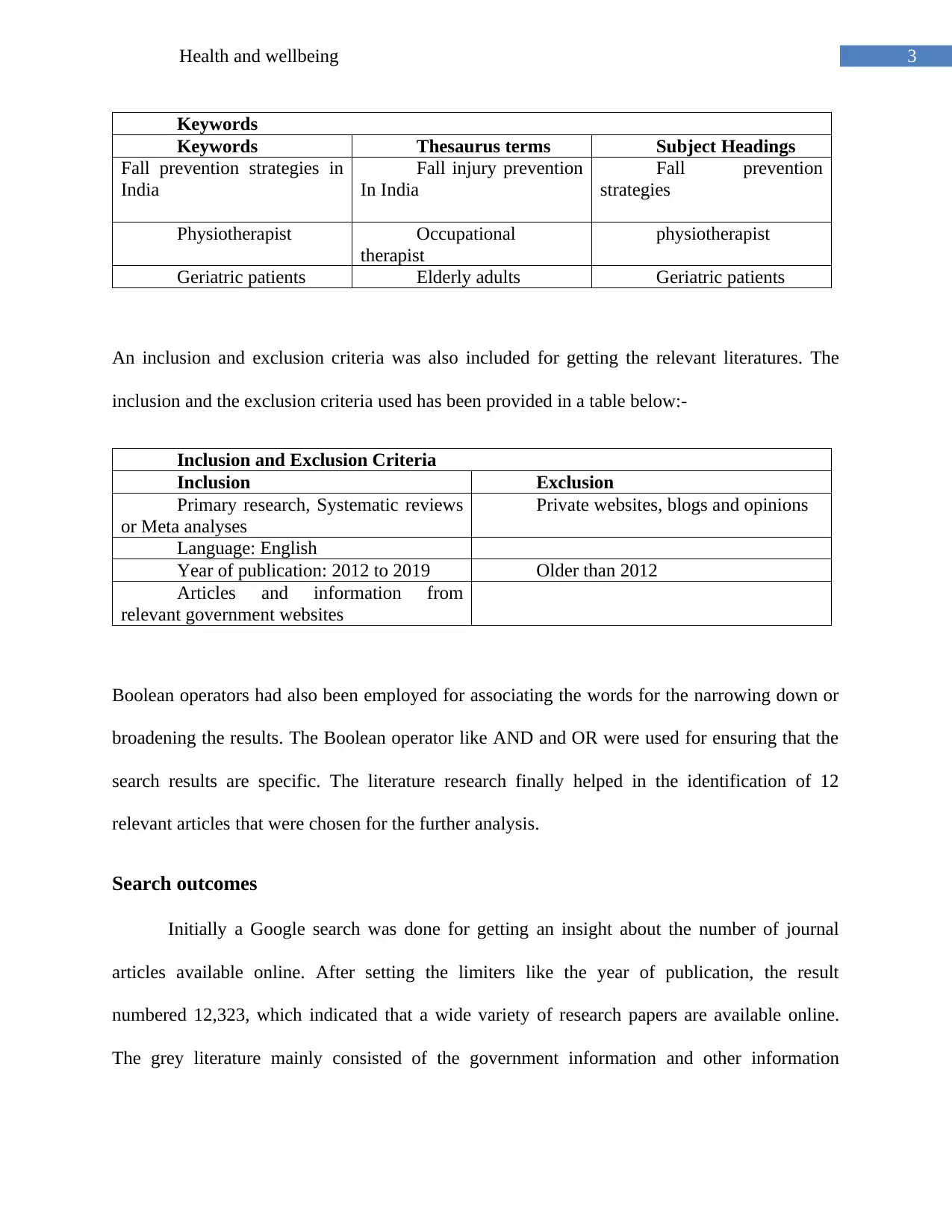
3Health and wellbeing
Keywords
Keywords Thesaurus terms Subject Headings
Fall prevention strategies in
India
Fall injury prevention
In India
Fall prevention
strategies
Physiotherapist Occupational
therapist
physiotherapist
Geriatric patients Elderly adults Geriatric patients
An inclusion and exclusion criteria was also included for getting the relevant literatures. The
inclusion and the exclusion criteria used has been provided in a table below:-
Inclusion and Exclusion Criteria
Inclusion Exclusion
Primary research, Systematic reviews
or Meta analyses
Private websites, blogs and opinions
Language: English
Year of publication: 2012 to 2019 Older than 2012
Articles and information from
relevant government websites
Boolean operators had also been employed for associating the words for the narrowing down or
broadening the results. The Boolean operator like AND and OR were used for ensuring that the
search results are specific. The literature research finally helped in the identification of 12
relevant articles that were chosen for the further analysis.
Search outcomes
Initially a Google search was done for getting an insight about the number of journal
articles available online. After setting the limiters like the year of publication, the result
numbered 12,323, which indicated that a wide variety of research papers are available online.
The grey literature mainly consisted of the government information and other information
Keywords
Keywords Thesaurus terms Subject Headings
Fall prevention strategies in
India
Fall injury prevention
In India
Fall prevention
strategies
Physiotherapist Occupational
therapist
physiotherapist
Geriatric patients Elderly adults Geriatric patients
An inclusion and exclusion criteria was also included for getting the relevant literatures. The
inclusion and the exclusion criteria used has been provided in a table below:-
Inclusion and Exclusion Criteria
Inclusion Exclusion
Primary research, Systematic reviews
or Meta analyses
Private websites, blogs and opinions
Language: English
Year of publication: 2012 to 2019 Older than 2012
Articles and information from
relevant government websites
Boolean operators had also been employed for associating the words for the narrowing down or
broadening the results. The Boolean operator like AND and OR were used for ensuring that the
search results are specific. The literature research finally helped in the identification of 12
relevant articles that were chosen for the further analysis.
Search outcomes
Initially a Google search was done for getting an insight about the number of journal
articles available online. After setting the limiters like the year of publication, the result
numbered 12,323, which indicated that a wide variety of research papers are available online.
The grey literature mainly consisted of the government information and other information
Secure Best Marks with AI Grader
Need help grading? Try our AI Grader for instant feedback on your assignments.
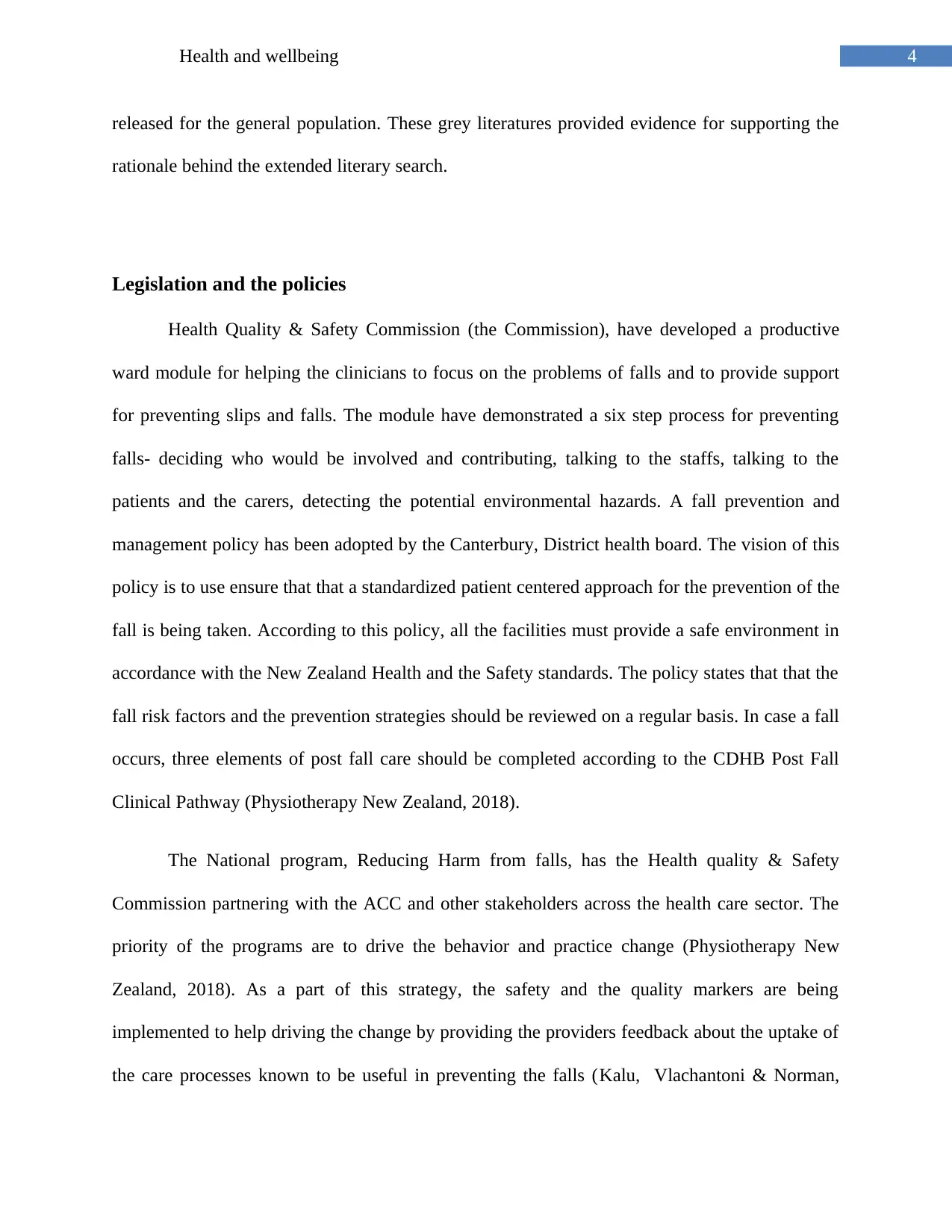
4Health and wellbeing
released for the general population. These grey literatures provided evidence for supporting the
rationale behind the extended literary search.
Legislation and the policies
Health Quality & Safety Commission (the Commission), have developed a productive
ward module for helping the clinicians to focus on the problems of falls and to provide support
for preventing slips and falls. The module have demonstrated a six step process for preventing
falls- deciding who would be involved and contributing, talking to the staffs, talking to the
patients and the carers, detecting the potential environmental hazards. A fall prevention and
management policy has been adopted by the Canterbury, District health board. The vision of this
policy is to use ensure that that a standardized patient centered approach for the prevention of the
fall is being taken. According to this policy, all the facilities must provide a safe environment in
accordance with the New Zealand Health and the Safety standards. The policy states that that the
fall risk factors and the prevention strategies should be reviewed on a regular basis. In case a fall
occurs, three elements of post fall care should be completed according to the CDHB Post Fall
Clinical Pathway (Physiotherapy New Zealand, 2018).
The National program, Reducing Harm from falls, has the Health quality & Safety
Commission partnering with the ACC and other stakeholders across the health care sector. The
priority of the programs are to drive the behavior and practice change (Physiotherapy New
Zealand, 2018). As a part of this strategy, the safety and the quality markers are being
implemented to help driving the change by providing the providers feedback about the uptake of
the care processes known to be useful in preventing the falls (Kalu, Vlachantoni & Norman,
released for the general population. These grey literatures provided evidence for supporting the
rationale behind the extended literary search.
Legislation and the policies
Health Quality & Safety Commission (the Commission), have developed a productive
ward module for helping the clinicians to focus on the problems of falls and to provide support
for preventing slips and falls. The module have demonstrated a six step process for preventing
falls- deciding who would be involved and contributing, talking to the staffs, talking to the
patients and the carers, detecting the potential environmental hazards. A fall prevention and
management policy has been adopted by the Canterbury, District health board. The vision of this
policy is to use ensure that that a standardized patient centered approach for the prevention of the
fall is being taken. According to this policy, all the facilities must provide a safe environment in
accordance with the New Zealand Health and the Safety standards. The policy states that that the
fall risk factors and the prevention strategies should be reviewed on a regular basis. In case a fall
occurs, three elements of post fall care should be completed according to the CDHB Post Fall
Clinical Pathway (Physiotherapy New Zealand, 2018).
The National program, Reducing Harm from falls, has the Health quality & Safety
Commission partnering with the ACC and other stakeholders across the health care sector. The
priority of the programs are to drive the behavior and practice change (Physiotherapy New
Zealand, 2018). As a part of this strategy, the safety and the quality markers are being
implemented to help driving the change by providing the providers feedback about the uptake of
the care processes known to be useful in preventing the falls (Kalu, Vlachantoni & Norman,
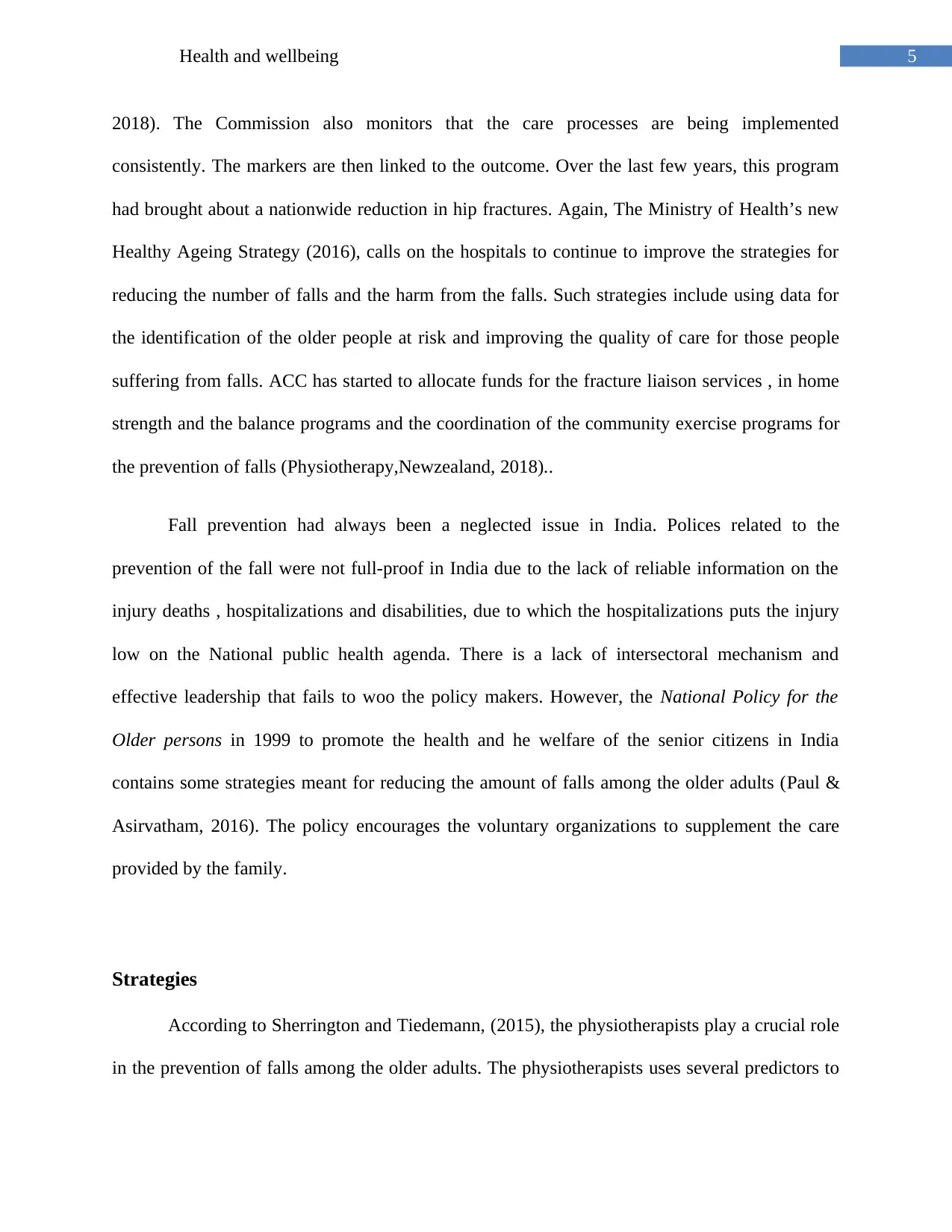
5Health and wellbeing
2018). The Commission also monitors that the care processes are being implemented
consistently. The markers are then linked to the outcome. Over the last few years, this program
had brought about a nationwide reduction in hip fractures. Again, The Ministry of Health’s new
Healthy Ageing Strategy (2016), calls on the hospitals to continue to improve the strategies for
reducing the number of falls and the harm from the falls. Such strategies include using data for
the identification of the older people at risk and improving the quality of care for those people
suffering from falls. ACC has started to allocate funds for the fracture liaison services , in home
strength and the balance programs and the coordination of the community exercise programs for
the prevention of falls (Physiotherapy,Newzealand, 2018)..
Fall prevention had always been a neglected issue in India. Polices related to the
prevention of the fall were not full-proof in India due to the lack of reliable information on the
injury deaths , hospitalizations and disabilities, due to which the hospitalizations puts the injury
low on the National public health agenda. There is a lack of intersectoral mechanism and
effective leadership that fails to woo the policy makers. However, the National Policy for the
Older persons in 1999 to promote the health and he welfare of the senior citizens in India
contains some strategies meant for reducing the amount of falls among the older adults (Paul &
Asirvatham, 2016). The policy encourages the voluntary organizations to supplement the care
provided by the family.
Strategies
According to Sherrington and Tiedemann, (2015), the physiotherapists play a crucial role
in the prevention of falls among the older adults. The physiotherapists uses several predictors to
2018). The Commission also monitors that the care processes are being implemented
consistently. The markers are then linked to the outcome. Over the last few years, this program
had brought about a nationwide reduction in hip fractures. Again, The Ministry of Health’s new
Healthy Ageing Strategy (2016), calls on the hospitals to continue to improve the strategies for
reducing the number of falls and the harm from the falls. Such strategies include using data for
the identification of the older people at risk and improving the quality of care for those people
suffering from falls. ACC has started to allocate funds for the fracture liaison services , in home
strength and the balance programs and the coordination of the community exercise programs for
the prevention of falls (Physiotherapy,Newzealand, 2018)..
Fall prevention had always been a neglected issue in India. Polices related to the
prevention of the fall were not full-proof in India due to the lack of reliable information on the
injury deaths , hospitalizations and disabilities, due to which the hospitalizations puts the injury
low on the National public health agenda. There is a lack of intersectoral mechanism and
effective leadership that fails to woo the policy makers. However, the National Policy for the
Older persons in 1999 to promote the health and he welfare of the senior citizens in India
contains some strategies meant for reducing the amount of falls among the older adults (Paul &
Asirvatham, 2016). The policy encourages the voluntary organizations to supplement the care
provided by the family.
Strategies
According to Sherrington and Tiedemann, (2015), the physiotherapists play a crucial role
in the prevention of falls among the older adults. The physiotherapists uses several predictors to
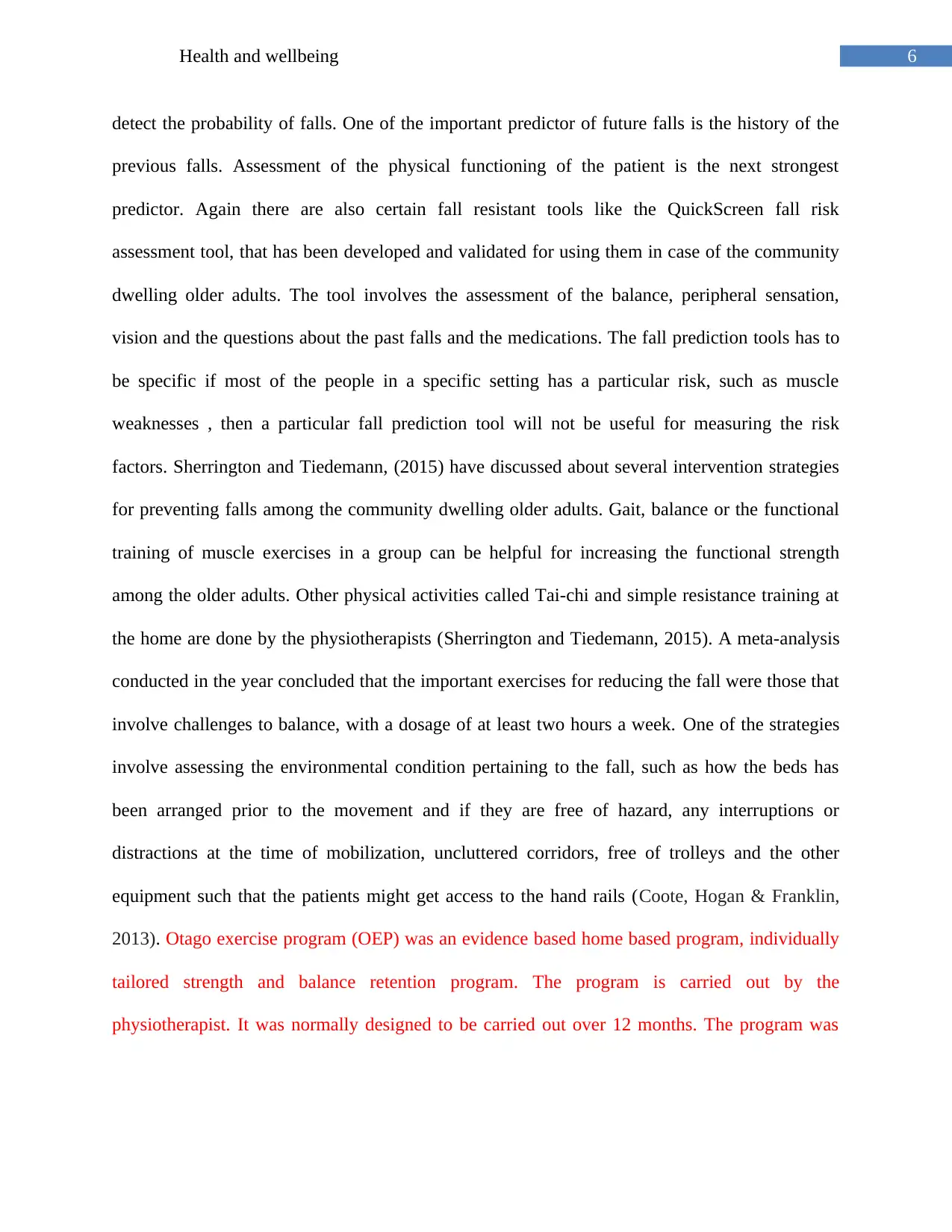
6Health and wellbeing
detect the probability of falls. One of the important predictor of future falls is the history of the
previous falls. Assessment of the physical functioning of the patient is the next strongest
predictor. Again there are also certain fall resistant tools like the QuickScreen fall risk
assessment tool, that has been developed and validated for using them in case of the community
dwelling older adults. The tool involves the assessment of the balance, peripheral sensation,
vision and the questions about the past falls and the medications. The fall prediction tools has to
be specific if most of the people in a specific setting has a particular risk, such as muscle
weaknesses , then a particular fall prediction tool will not be useful for measuring the risk
factors. Sherrington and Tiedemann, (2015) have discussed about several intervention strategies
for preventing falls among the community dwelling older adults. Gait, balance or the functional
training of muscle exercises in a group can be helpful for increasing the functional strength
among the older adults. Other physical activities called Tai-chi and simple resistance training at
the home are done by the physiotherapists (Sherrington and Tiedemann, 2015). A meta-analysis
conducted in the year concluded that the important exercises for reducing the fall were those that
involve challenges to balance, with a dosage of at least two hours a week. One of the strategies
involve assessing the environmental condition pertaining to the fall, such as how the beds has
been arranged prior to the movement and if they are free of hazard, any interruptions or
distractions at the time of mobilization, uncluttered corridors, free of trolleys and the other
equipment such that the patients might get access to the hand rails (Coote, Hogan & Franklin,
2013). Otago exercise program (OEP) was an evidence based home based program, individually
tailored strength and balance retention program. The program is carried out by the
physiotherapist. It was normally designed to be carried out over 12 months. The program was
detect the probability of falls. One of the important predictor of future falls is the history of the
previous falls. Assessment of the physical functioning of the patient is the next strongest
predictor. Again there are also certain fall resistant tools like the QuickScreen fall risk
assessment tool, that has been developed and validated for using them in case of the community
dwelling older adults. The tool involves the assessment of the balance, peripheral sensation,
vision and the questions about the past falls and the medications. The fall prediction tools has to
be specific if most of the people in a specific setting has a particular risk, such as muscle
weaknesses , then a particular fall prediction tool will not be useful for measuring the risk
factors. Sherrington and Tiedemann, (2015) have discussed about several intervention strategies
for preventing falls among the community dwelling older adults. Gait, balance or the functional
training of muscle exercises in a group can be helpful for increasing the functional strength
among the older adults. Other physical activities called Tai-chi and simple resistance training at
the home are done by the physiotherapists (Sherrington and Tiedemann, 2015). A meta-analysis
conducted in the year concluded that the important exercises for reducing the fall were those that
involve challenges to balance, with a dosage of at least two hours a week. One of the strategies
involve assessing the environmental condition pertaining to the fall, such as how the beds has
been arranged prior to the movement and if they are free of hazard, any interruptions or
distractions at the time of mobilization, uncluttered corridors, free of trolleys and the other
equipment such that the patients might get access to the hand rails (Coote, Hogan & Franklin,
2013). Otago exercise program (OEP) was an evidence based home based program, individually
tailored strength and balance retention program. The program is carried out by the
physiotherapist. It was normally designed to be carried out over 12 months. The program was
Paraphrase This Document
Need a fresh take? Get an instant paraphrase of this document with our AI Paraphraser
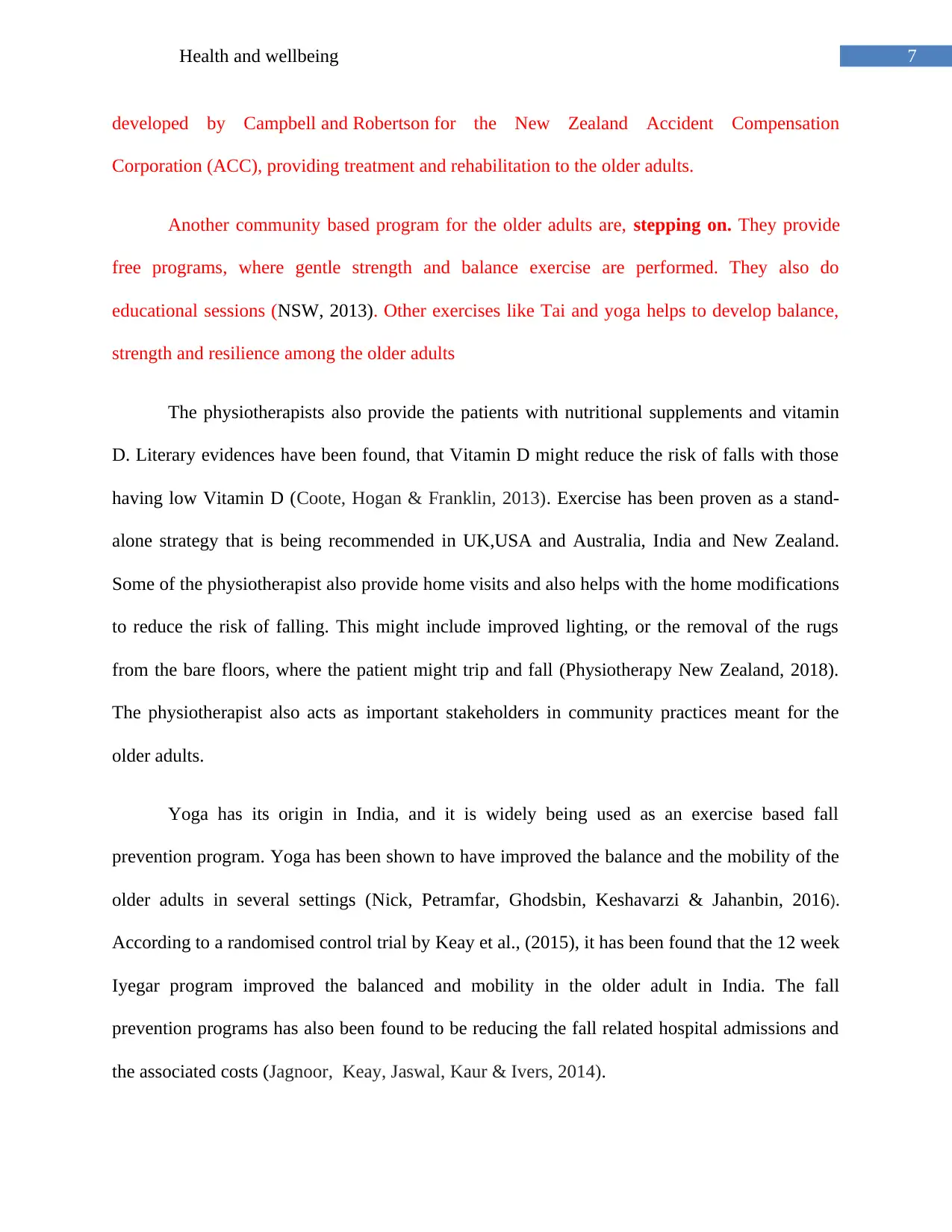
7Health and wellbeing
developed by Campbell and Robertson for the New Zealand Accident Compensation
Corporation (ACC), providing treatment and rehabilitation to the older adults.
Another community based program for the older adults are, stepping on. They provide
free programs, where gentle strength and balance exercise are performed. They also do
educational sessions (NSW, 2013). Other exercises like Tai and yoga helps to develop balance,
strength and resilience among the older adults
The physiotherapists also provide the patients with nutritional supplements and vitamin
D. Literary evidences have been found, that Vitamin D might reduce the risk of falls with those
having low Vitamin D (Coote, Hogan & Franklin, 2013). Exercise has been proven as a stand-
alone strategy that is being recommended in UK,USA and Australia, India and New Zealand.
Some of the physiotherapist also provide home visits and also helps with the home modifications
to reduce the risk of falling. This might include improved lighting, or the removal of the rugs
from the bare floors, where the patient might trip and fall (Physiotherapy New Zealand, 2018).
The physiotherapist also acts as important stakeholders in community practices meant for the
older adults.
Yoga has its origin in India, and it is widely being used as an exercise based fall
prevention program. Yoga has been shown to have improved the balance and the mobility of the
older adults in several settings (Nick, Petramfar, Ghodsbin, Keshavarzi & Jahanbin, 2016).
According to a randomised control trial by Keay et al., (2015), it has been found that the 12 week
Iyegar program improved the balanced and mobility in the older adult in India. The fall
prevention programs has also been found to be reducing the fall related hospital admissions and
the associated costs (Jagnoor, Keay, Jaswal, Kaur & Ivers, 2014).
developed by Campbell and Robertson for the New Zealand Accident Compensation
Corporation (ACC), providing treatment and rehabilitation to the older adults.
Another community based program for the older adults are, stepping on. They provide
free programs, where gentle strength and balance exercise are performed. They also do
educational sessions (NSW, 2013). Other exercises like Tai and yoga helps to develop balance,
strength and resilience among the older adults
The physiotherapists also provide the patients with nutritional supplements and vitamin
D. Literary evidences have been found, that Vitamin D might reduce the risk of falls with those
having low Vitamin D (Coote, Hogan & Franklin, 2013). Exercise has been proven as a stand-
alone strategy that is being recommended in UK,USA and Australia, India and New Zealand.
Some of the physiotherapist also provide home visits and also helps with the home modifications
to reduce the risk of falling. This might include improved lighting, or the removal of the rugs
from the bare floors, where the patient might trip and fall (Physiotherapy New Zealand, 2018).
The physiotherapist also acts as important stakeholders in community practices meant for the
older adults.
Yoga has its origin in India, and it is widely being used as an exercise based fall
prevention program. Yoga has been shown to have improved the balance and the mobility of the
older adults in several settings (Nick, Petramfar, Ghodsbin, Keshavarzi & Jahanbin, 2016).
According to a randomised control trial by Keay et al., (2015), it has been found that the 12 week
Iyegar program improved the balanced and mobility in the older adult in India. The fall
prevention programs has also been found to be reducing the fall related hospital admissions and
the associated costs (Jagnoor, Keay, Jaswal, Kaur & Ivers, 2014).
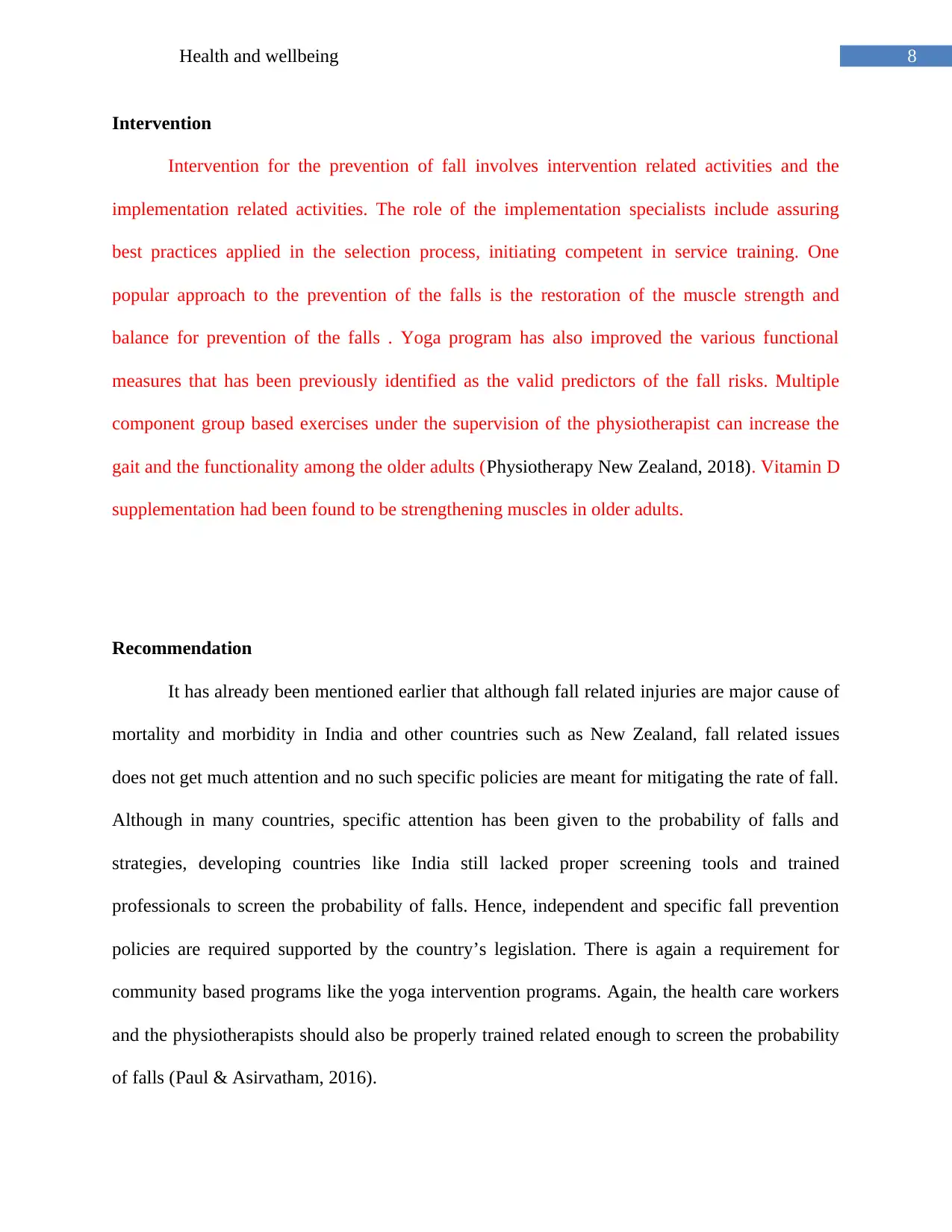
8Health and wellbeing
Intervention
Intervention for the prevention of fall involves intervention related activities and the
implementation related activities. The role of the implementation specialists include assuring
best practices applied in the selection process, initiating competent in service training. One
popular approach to the prevention of the falls is the restoration of the muscle strength and
balance for prevention of the falls . Yoga program has also improved the various functional
measures that has been previously identified as the valid predictors of the fall risks. Multiple
component group based exercises under the supervision of the physiotherapist can increase the
gait and the functionality among the older adults (Physiotherapy New Zealand, 2018). Vitamin D
supplementation had been found to be strengthening muscles in older adults.
Recommendation
It has already been mentioned earlier that although fall related injuries are major cause of
mortality and morbidity in India and other countries such as New Zealand, fall related issues
does not get much attention and no such specific policies are meant for mitigating the rate of fall.
Although in many countries, specific attention has been given to the probability of falls and
strategies, developing countries like India still lacked proper screening tools and trained
professionals to screen the probability of falls. Hence, independent and specific fall prevention
policies are required supported by the country’s legislation. There is again a requirement for
community based programs like the yoga intervention programs. Again, the health care workers
and the physiotherapists should also be properly trained related enough to screen the probability
of falls (Paul & Asirvatham, 2016).
Intervention
Intervention for the prevention of fall involves intervention related activities and the
implementation related activities. The role of the implementation specialists include assuring
best practices applied in the selection process, initiating competent in service training. One
popular approach to the prevention of the falls is the restoration of the muscle strength and
balance for prevention of the falls . Yoga program has also improved the various functional
measures that has been previously identified as the valid predictors of the fall risks. Multiple
component group based exercises under the supervision of the physiotherapist can increase the
gait and the functionality among the older adults (Physiotherapy New Zealand, 2018). Vitamin D
supplementation had been found to be strengthening muscles in older adults.
Recommendation
It has already been mentioned earlier that although fall related injuries are major cause of
mortality and morbidity in India and other countries such as New Zealand, fall related issues
does not get much attention and no such specific policies are meant for mitigating the rate of fall.
Although in many countries, specific attention has been given to the probability of falls and
strategies, developing countries like India still lacked proper screening tools and trained
professionals to screen the probability of falls. Hence, independent and specific fall prevention
policies are required supported by the country’s legislation. There is again a requirement for
community based programs like the yoga intervention programs. Again, the health care workers
and the physiotherapists should also be properly trained related enough to screen the probability
of falls (Paul & Asirvatham, 2016).
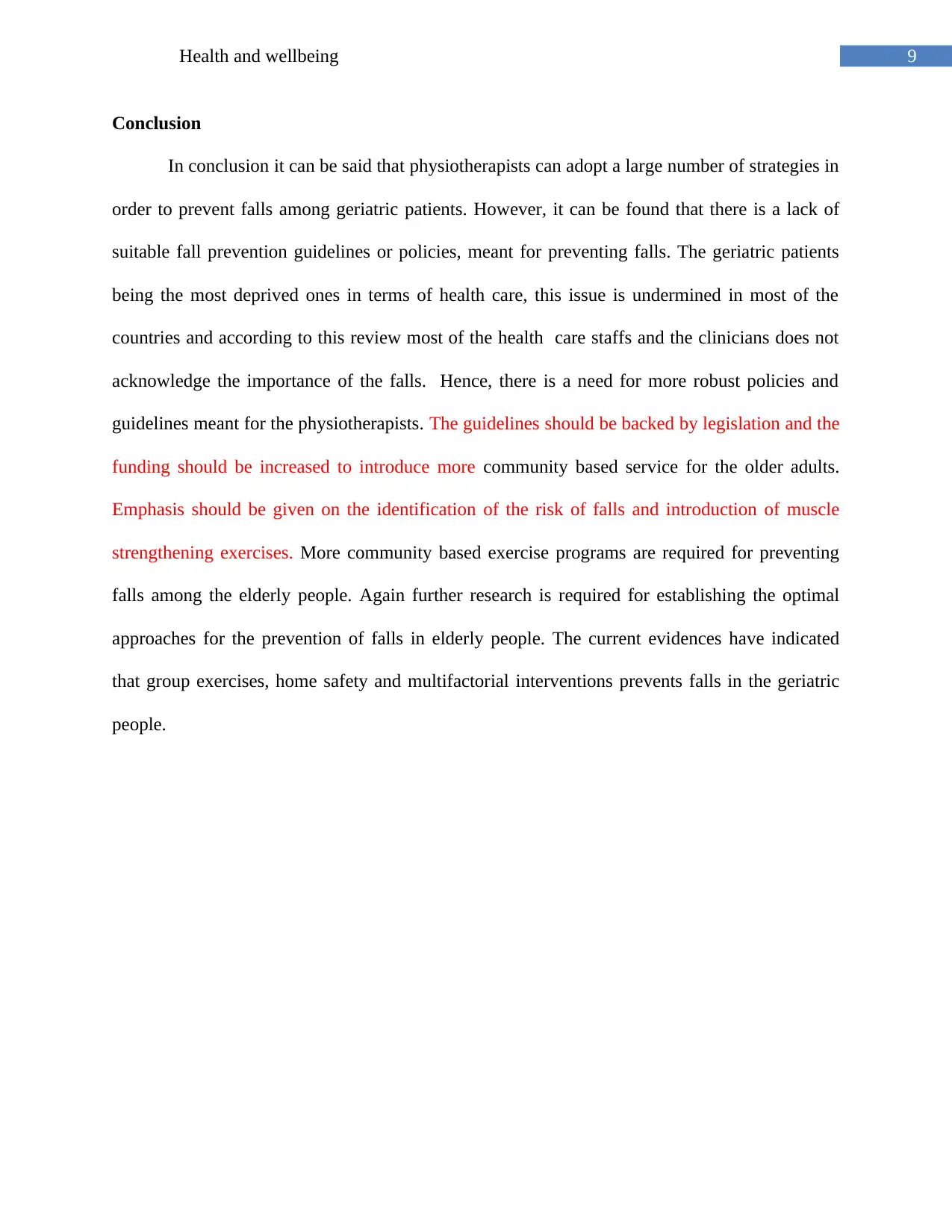
9Health and wellbeing
Conclusion
In conclusion it can be said that physiotherapists can adopt a large number of strategies in
order to prevent falls among geriatric patients. However, it can be found that there is a lack of
suitable fall prevention guidelines or policies, meant for preventing falls. The geriatric patients
being the most deprived ones in terms of health care, this issue is undermined in most of the
countries and according to this review most of the health care staffs and the clinicians does not
acknowledge the importance of the falls. Hence, there is a need for more robust policies and
guidelines meant for the physiotherapists. The guidelines should be backed by legislation and the
funding should be increased to introduce more community based service for the older adults.
Emphasis should be given on the identification of the risk of falls and introduction of muscle
strengthening exercises. More community based exercise programs are required for preventing
falls among the elderly people. Again further research is required for establishing the optimal
approaches for the prevention of falls in elderly people. The current evidences have indicated
that group exercises, home safety and multifactorial interventions prevents falls in the geriatric
people.
Conclusion
In conclusion it can be said that physiotherapists can adopt a large number of strategies in
order to prevent falls among geriatric patients. However, it can be found that there is a lack of
suitable fall prevention guidelines or policies, meant for preventing falls. The geriatric patients
being the most deprived ones in terms of health care, this issue is undermined in most of the
countries and according to this review most of the health care staffs and the clinicians does not
acknowledge the importance of the falls. Hence, there is a need for more robust policies and
guidelines meant for the physiotherapists. The guidelines should be backed by legislation and the
funding should be increased to introduce more community based service for the older adults.
Emphasis should be given on the identification of the risk of falls and introduction of muscle
strengthening exercises. More community based exercise programs are required for preventing
falls among the elderly people. Again further research is required for establishing the optimal
approaches for the prevention of falls in elderly people. The current evidences have indicated
that group exercises, home safety and multifactorial interventions prevents falls in the geriatric
people.
Secure Best Marks with AI Grader
Need help grading? Try our AI Grader for instant feedback on your assignments.

10Health and wellbeing
References
Asiri, F., ALMohiza, M. A., Faia Aseeri, M., Mehtab Alam, M., Ataalla, S. M., Alqahtani, M., &
Alshahrani, A. (2018). Fall prevention knowledge and practice patterns among home
healthcare professionals in southern Saudi Arabia: an observational study. Journal of
international medical research, 46(12), 5062-5073.
https://doi.org/10.1177/0300060518789816
Cadore, E. L., Rodríguez-Mañas, L., Sinclair, A., & Izquierdo, M. (2013). Effects of different
exercise interventions on risk of falls, gait ability, and balance in physically frail older
adults: a systematic review. Rejuvenation research, 16(2), 105-
114.https://doi.org/10.1089/rej.2012.1397
Coote, S., Hogan, N., & Franklin, S. (2013). Falls in people with multiple sclerosis who use a
walking aid: prevalence, factors, and effect of strength and balance
interventions. Archives of Physical Medicine and Rehabilitation, 94(4), 616-621.
https://doi.org/10.1016/j.apmr.2012.10.020
Dsouza, S. A., Rajashekar, B., Dsouza, H. S., & Kumar, K. B. (2014). Falls in Indian older
adults: a barrier to active ageing. Asian J Gerontol Geriatr, 9(1), 1-8.
doi=10.1.1.671.5642
Jagnoor, J., Keay, L., Jaswal, N., Kaur, M., & Ivers, R. (2014). A qualitative study on the
perceptions of preventing falls as a health priority among older people in Northern
India. Injury prevention, 20(1), 29-34. http://dx.doi.org/10.1136/injuryprev-2012-040707
References
Asiri, F., ALMohiza, M. A., Faia Aseeri, M., Mehtab Alam, M., Ataalla, S. M., Alqahtani, M., &
Alshahrani, A. (2018). Fall prevention knowledge and practice patterns among home
healthcare professionals in southern Saudi Arabia: an observational study. Journal of
international medical research, 46(12), 5062-5073.
https://doi.org/10.1177/0300060518789816
Cadore, E. L., Rodríguez-Mañas, L., Sinclair, A., & Izquierdo, M. (2013). Effects of different
exercise interventions on risk of falls, gait ability, and balance in physically frail older
adults: a systematic review. Rejuvenation research, 16(2), 105-
114.https://doi.org/10.1089/rej.2012.1397
Coote, S., Hogan, N., & Franklin, S. (2013). Falls in people with multiple sclerosis who use a
walking aid: prevalence, factors, and effect of strength and balance
interventions. Archives of Physical Medicine and Rehabilitation, 94(4), 616-621.
https://doi.org/10.1016/j.apmr.2012.10.020
Dsouza, S. A., Rajashekar, B., Dsouza, H. S., & Kumar, K. B. (2014). Falls in Indian older
adults: a barrier to active ageing. Asian J Gerontol Geriatr, 9(1), 1-8.
doi=10.1.1.671.5642
Jagnoor, J., Keay, L., Jaswal, N., Kaur, M., & Ivers, R. (2014). A qualitative study on the
perceptions of preventing falls as a health priority among older people in Northern
India. Injury prevention, 20(1), 29-34. http://dx.doi.org/10.1136/injuryprev-2012-040707
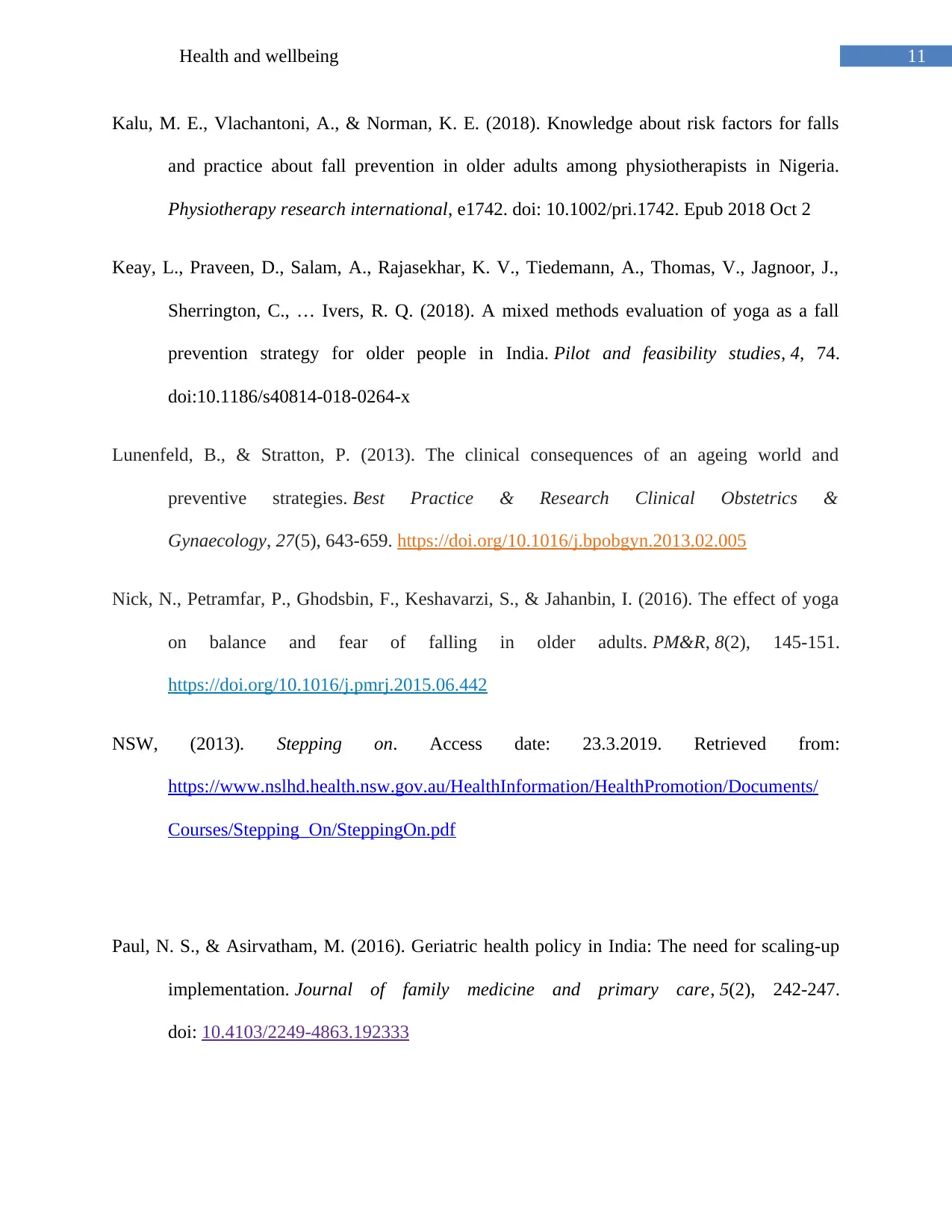
11Health and wellbeing
Kalu, M. E., Vlachantoni, A., & Norman, K. E. (2018). Knowledge about risk factors for falls
and practice about fall prevention in older adults among physiotherapists in Nigeria.
Physiotherapy research international, e1742. doi: 10.1002/pri.1742. Epub 2018 Oct 2
Keay, L., Praveen, D., Salam, A., Rajasekhar, K. V., Tiedemann, A., Thomas, V., Jagnoor, J.,
Sherrington, C., … Ivers, R. Q. (2018). A mixed methods evaluation of yoga as a fall
prevention strategy for older people in India. Pilot and feasibility studies, 4, 74.
doi:10.1186/s40814-018-0264-x
Lunenfeld, B., & Stratton, P. (2013). The clinical consequences of an ageing world and
preventive strategies. Best Practice & Research Clinical Obstetrics &
Gynaecology, 27(5), 643-659. https://doi.org/10.1016/j.bpobgyn.2013.02.005
Nick, N., Petramfar, P., Ghodsbin, F., Keshavarzi, S., & Jahanbin, I. (2016). The effect of yoga
on balance and fear of falling in older adults. PM&R, 8(2), 145-151.
https://doi.org/10.1016/j.pmrj.2015.06.442
NSW, (2013). Stepping on. Access date: 23.3.2019. Retrieved from:
https://www.nslhd.health.nsw.gov.au/HealthInformation/HealthPromotion/Documents/
Courses/Stepping_On/SteppingOn.pdf
Paul, N. S., & Asirvatham, M. (2016). Geriatric health policy in India: The need for scaling-up
implementation. Journal of family medicine and primary care, 5(2), 242-247.
doi: 10.4103/2249-4863.192333
Kalu, M. E., Vlachantoni, A., & Norman, K. E. (2018). Knowledge about risk factors for falls
and practice about fall prevention in older adults among physiotherapists in Nigeria.
Physiotherapy research international, e1742. doi: 10.1002/pri.1742. Epub 2018 Oct 2
Keay, L., Praveen, D., Salam, A., Rajasekhar, K. V., Tiedemann, A., Thomas, V., Jagnoor, J.,
Sherrington, C., … Ivers, R. Q. (2018). A mixed methods evaluation of yoga as a fall
prevention strategy for older people in India. Pilot and feasibility studies, 4, 74.
doi:10.1186/s40814-018-0264-x
Lunenfeld, B., & Stratton, P. (2013). The clinical consequences of an ageing world and
preventive strategies. Best Practice & Research Clinical Obstetrics &
Gynaecology, 27(5), 643-659. https://doi.org/10.1016/j.bpobgyn.2013.02.005
Nick, N., Petramfar, P., Ghodsbin, F., Keshavarzi, S., & Jahanbin, I. (2016). The effect of yoga
on balance and fear of falling in older adults. PM&R, 8(2), 145-151.
https://doi.org/10.1016/j.pmrj.2015.06.442
NSW, (2013). Stepping on. Access date: 23.3.2019. Retrieved from:
https://www.nslhd.health.nsw.gov.au/HealthInformation/HealthPromotion/Documents/
Courses/Stepping_On/SteppingOn.pdf
Paul, N. S., & Asirvatham, M. (2016). Geriatric health policy in India: The need for scaling-up
implementation. Journal of family medicine and primary care, 5(2), 242-247.
doi: 10.4103/2249-4863.192333
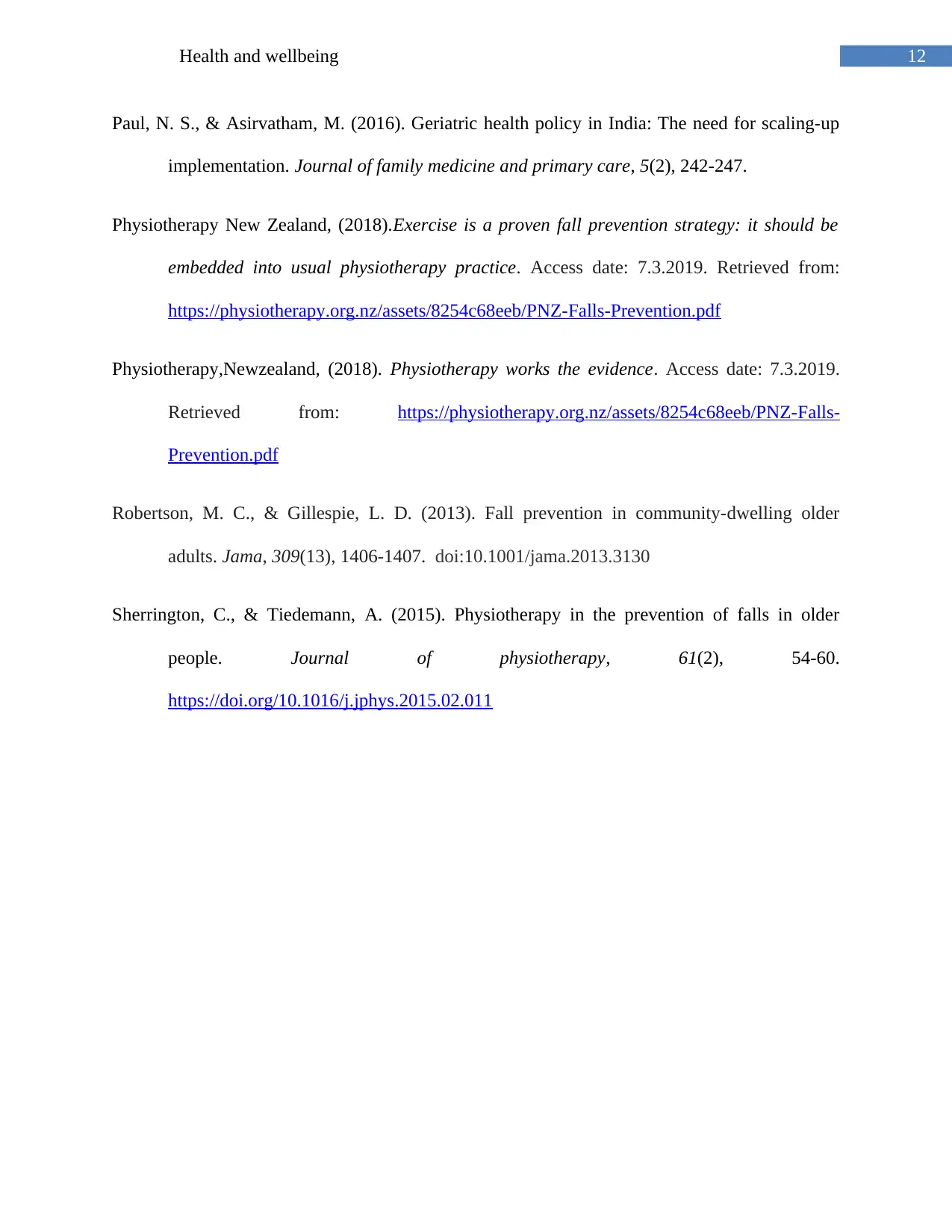
12Health and wellbeing
Paul, N. S., & Asirvatham, M. (2016). Geriatric health policy in India: The need for scaling-up
implementation. Journal of family medicine and primary care, 5(2), 242-247.
Physiotherapy New Zealand, (2018).Exercise is a proven fall prevention strategy: it should be
embedded into usual physiotherapy practice. Access date: 7.3.2019. Retrieved from:
https://physiotherapy.org.nz/assets/8254c68eeb/PNZ-Falls-Prevention.pdf
Physiotherapy,Newzealand, (2018). Physiotherapy works the evidence. Access date: 7.3.2019.
Retrieved from: https://physiotherapy.org.nz/assets/8254c68eeb/PNZ-Falls-
Prevention.pdf
Robertson, M. C., & Gillespie, L. D. (2013). Fall prevention in community-dwelling older
adults. Jama, 309(13), 1406-1407. doi:10.1001/jama.2013.3130
Sherrington, C., & Tiedemann, A. (2015). Physiotherapy in the prevention of falls in older
people. Journal of physiotherapy, 61(2), 54-60.
https://doi.org/10.1016/j.jphys.2015.02.011
Paul, N. S., & Asirvatham, M. (2016). Geriatric health policy in India: The need for scaling-up
implementation. Journal of family medicine and primary care, 5(2), 242-247.
Physiotherapy New Zealand, (2018).Exercise is a proven fall prevention strategy: it should be
embedded into usual physiotherapy practice. Access date: 7.3.2019. Retrieved from:
https://physiotherapy.org.nz/assets/8254c68eeb/PNZ-Falls-Prevention.pdf
Physiotherapy,Newzealand, (2018). Physiotherapy works the evidence. Access date: 7.3.2019.
Retrieved from: https://physiotherapy.org.nz/assets/8254c68eeb/PNZ-Falls-
Prevention.pdf
Robertson, M. C., & Gillespie, L. D. (2013). Fall prevention in community-dwelling older
adults. Jama, 309(13), 1406-1407. doi:10.1001/jama.2013.3130
Sherrington, C., & Tiedemann, A. (2015). Physiotherapy in the prevention of falls in older
people. Journal of physiotherapy, 61(2), 54-60.
https://doi.org/10.1016/j.jphys.2015.02.011
1 out of 13
Related Documents
Your All-in-One AI-Powered Toolkit for Academic Success.
+13062052269
info@desklib.com
Available 24*7 on WhatsApp / Email
![[object Object]](/_next/static/media/star-bottom.7253800d.svg)
Unlock your academic potential
© 2024 | Zucol Services PVT LTD | All rights reserved.





